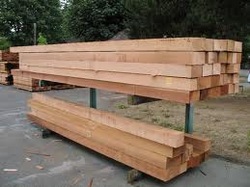Western Red Cedar grows in low to mid elevations, along the
coast and in a wet belt of the interior. It prefers cool, moist locations, and
a slightly acidic soil. The tree can be described as large to very large, with
a tapering trunk that often spreads widely at the base. A mature tree can
attain a height of 180 feet with a trunk diameter of 8 feet. The Western Red
Cedar is slow-growing and long-lived. A specimen can live upwards of 1000
years, and has one of the longest lifespans of any North American softwood.
Cedar has a low density of 22 lbs. per cubic foot, with a low specific gravity
of 0.33. This makes it one of the lightest softwoods available, but also soft,
and prone to indentation. The low density also gives cedar it's excellent
thermal insulation properties.
The heartwood of Western Red Cedar contains extractives that
are toxic to the decay-causing fungi. Two principle agents responsible for this
decay resistance are Thujaplicans (taken from the scientific name for Western
Red Cedar) and water soluble phenolics. The tree's ability to produce these
agents increases with age, making the outer layers of the heartwood the most
resistant. (In general, sapwood, in all species, has a low resistance to decay)
These naturally occurring substances repel moths, insects, termites, carpenter
ants and bees, and ambrosia beetles - the bugs just don't like cedar and prefer
to eat elsewhere.
Western Red Cedar has very distinctive heartwood and sapwood.
The sapwood is whitish-cream in color, seldom greater than 1" wide in mature
trees, and is clearly delineated from the heartwood. The heartwood color varies
considerably more, and is not consistent in color at all. Freshly cut Western
Red Cedar can vary from a dark chocolate brown color to a salmon pink, and can
be variegated. The color ages to the more familiar reddish-brown, and
eventually to a silver-gray with exposure to the elements.
coast and in a wet belt of the interior. It prefers cool, moist locations, and
a slightly acidic soil. The tree can be described as large to very large, with
a tapering trunk that often spreads widely at the base. A mature tree can
attain a height of 180 feet with a trunk diameter of 8 feet. The Western Red
Cedar is slow-growing and long-lived. A specimen can live upwards of 1000
years, and has one of the longest lifespans of any North American softwood.
Cedar has a low density of 22 lbs. per cubic foot, with a low specific gravity
of 0.33. This makes it one of the lightest softwoods available, but also soft,
and prone to indentation. The low density also gives cedar it's excellent
thermal insulation properties.
The heartwood of Western Red Cedar contains extractives that
are toxic to the decay-causing fungi. Two principle agents responsible for this
decay resistance are Thujaplicans (taken from the scientific name for Western
Red Cedar) and water soluble phenolics. The tree's ability to produce these
agents increases with age, making the outer layers of the heartwood the most
resistant. (In general, sapwood, in all species, has a low resistance to decay)
These naturally occurring substances repel moths, insects, termites, carpenter
ants and bees, and ambrosia beetles - the bugs just don't like cedar and prefer
to eat elsewhere.
Western Red Cedar has very distinctive heartwood and sapwood.
The sapwood is whitish-cream in color, seldom greater than 1" wide in mature
trees, and is clearly delineated from the heartwood. The heartwood color varies
considerably more, and is not consistent in color at all. Freshly cut Western
Red Cedar can vary from a dark chocolate brown color to a salmon pink, and can
be variegated. The color ages to the more familiar reddish-brown, and
eventually to a silver-gray with exposure to the elements.

